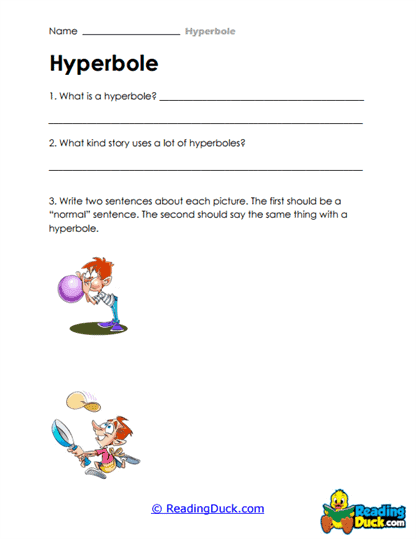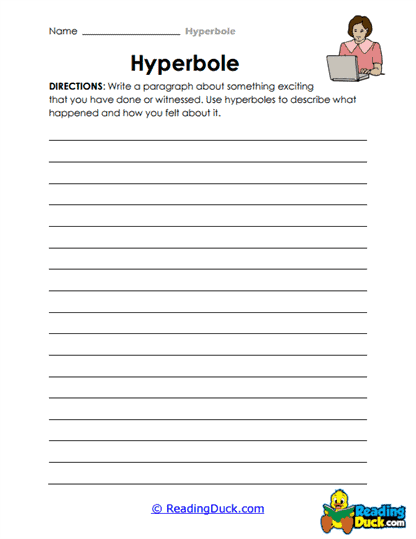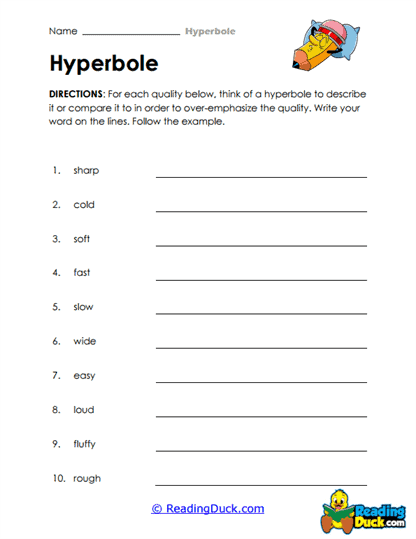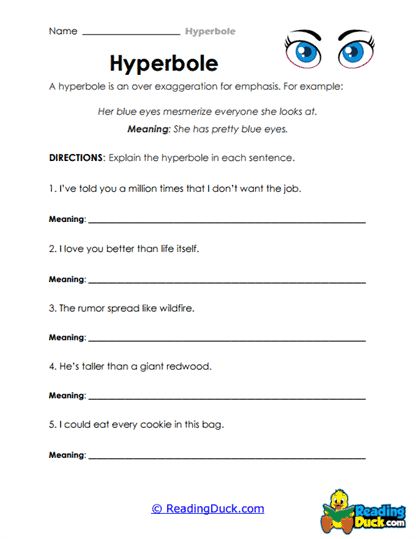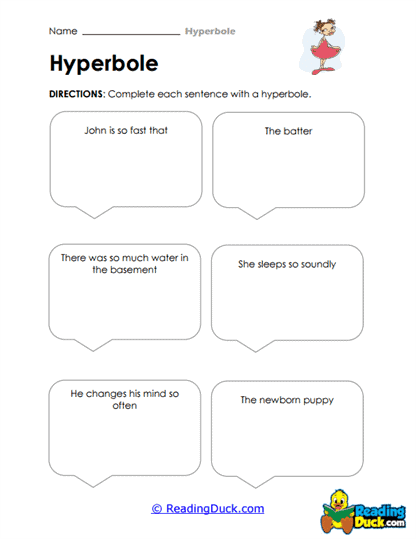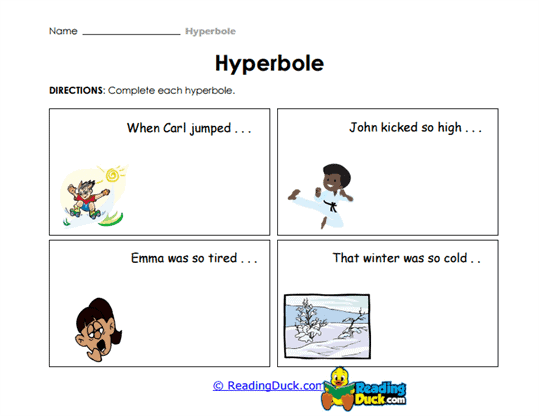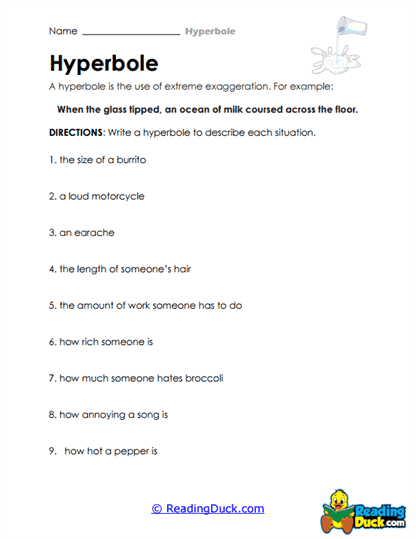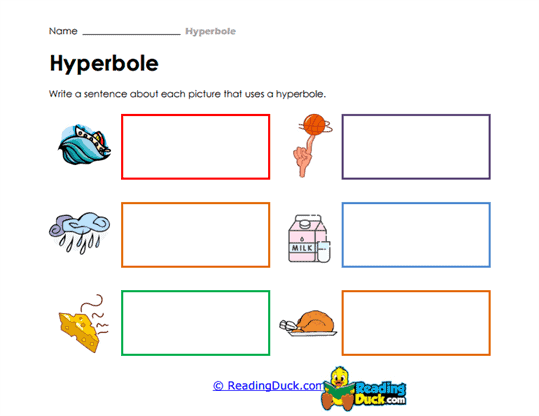Hyperbole Worksheets
About Our Hyperbole Worksheets
Our collection of Hyperbole Worksheets falls under the Language category within the Skills section, designed to help students recognize, understand, and effectively use hyperbole. Hyperbole is a key literary device that involves intentional exaggeration for emphasis or effect. By mastering hyperbole, students enhance their ability to interpret more nuanced language and improve their creative writing skills. These worksheets guide students through identifying and creating hyperbolic statements, offering a structured and engaging approach to mastering this figure of speech.
The worksheets are provided in PDF format, making them easy to access, download, and print for both classroom and home learning. Each worksheet comes with a downloadable answer key, allowing students and educators to review progress and check understanding in a simple, efficient way.
What is Hyperbole?
Hyperbole is a rhetorical device used to express exaggerated statements that are not meant to be taken literally. It is a form of figurative language that emphasizes an idea or makes a statement more impactful by overstating the situation. Learning to understand and use hyperbole adds richness to a student’s language skills, making their communication more dynamic and expressive.
Key Aspects of Hyperbole
Intentional Exaggeration: Hyperbole involves an extreme exaggeration to emphasize a point or evoke strong emotions. The exaggeration is so bold that it is clear it cannot be taken literally.
-
- Example: "I’m so hungry I could eat a horse."
Purpose of Emphasis: The exaggeration in hyperbole is used to draw attention to a specific idea or emotion, creating a memorable effect for the reader or listener.
-
- Example: "This suitcase weighs a ton!" (The suitcase doesn’t actually weigh a ton, but it feels extremely heavy.)
Not Meant to be Literal: One of the defining characteristics of hyperbole is that it is not intended to be taken literally. It conveys a sense of magnitude or importance by overstating the actual situation.
-
- Example: "I’ve told you a million times to clean your room!"
Hyperbole is frequently used in literature, advertising, conversation, and even speeches to add flair, humor, or emphasis to communication.
Different Usages of Hyperbole
Hyperbole can be found in various forms of communication, and its versatility makes it an important tool for creating vivid and memorable expressions. Whether used for comedic effect or to emphasize an intense feeling, hyperbole helps communicate ideas more forcefully and creatively.
Hyperbole in Literature
In literature, hyperbole is often used to create strong imagery or emphasize a character’s emotions or experiences. Authors employ hyperbole to heighten the drama of a scene or to reflect the intensity of a character’s feelings.
- Example in literature: In Romeo and Juliet, Shakespeare uses hyperbole to express Romeo’s feelings for Juliet: "The brightness of her cheek would shame those stars." This exaggeration conveys the depth of Romeo’s admiration and love for Juliet.
Hyperbole helps readers visualize the scene or emotion being described, often making it more impactful or emotionally charged.
Hyperbole in Everyday Conversation
Hyperbole is frequently used in everyday speech to emphasize a point, often adding humor or drama to casual conversation. People use hyperbole to express feelings in an exaggerated way, making their communication more lively and engaging.
- Example in conversation: "I’ve been waiting forever for the bus!"
In this sentence, "forever" is used hyperbolically to stress that the speaker feels like they’ve been waiting for a long time, even though it hasn’t literally been forever.
Hyperbole in Advertising and Media
Advertisers often use hyperbole to make their products stand out or seem more appealing. By using exaggerated claims, they create a sense of excitement or urgency that encourages consumers to pay attention to their message.
- Example in advertising: "The best burgers in the world!" While this claim is exaggerated, it draws attention and emphasizes the idea that the burgers are of high quality.
Hyperbole in advertising is effective because it makes products or services sound more desirable, even though the statements may not be taken literally.
The Role of Hyperbole in Developing Literacy Skills
Learning to recognize and use hyperbole is crucial for developing strong literacy skills. By understanding how hyperbole functions, students can enhance their reading comprehension, become more creative writers, and express themselves more vividly in conversation.
Enhancing Reading Comprehension
Hyperbole frequently appears in literature, poetry, and even nonfiction texts. When students are able to identify hyperbolic statements, they improve their reading comprehension by understanding the author’s intent behind the exaggeration. Recognizing hyperbole helps students interpret a text’s tone and grasp the emotional weight behind a particular expression.
For instance, in a story where a character says, "I’m so tired I could sleep for a thousand years," students can recognize that the character is simply expressing extreme fatigue and doesn’t literally mean to sleep for that long. This understanding deepens their engagement with the text.
Improving Writing Skills
In writing, hyperbole allows students to add flair, drama, or humor to their work. Whether they are writing a descriptive essay, a fictional story, or a persuasive piece, the ability to use hyperbole effectively makes their writing more dynamic and interesting.
For example, instead of simply stating, "The concert was good," a student might write, "The concert was so amazing it shook the entire city!" This exaggerated statement conveys a sense of excitement and enthusiasm that makes the writing more engaging.
Strengthening Speaking and Listening Skills
Hyperbole is also common in verbal communication, especially in storytelling, debates, or informal conversations. By learning to use hyperbole appropriately, students can become more compelling speakers and active listeners. Recognizing when hyperbole is used in speech helps students better understand the speaker’s intent and adds to their ability to interpret tone and exaggeration in conversation.
For instance, in a debate or discussion, a student might say, "This policy will save millions of lives!" While the statement is an exaggeration, it emphasizes the importance of the policy in a dramatic way.
Engaging Activities to Reinforce Learning
Educators can enhance their students’ understanding of hyperbole by incorporating a variety of fun and interactive activities. These activities encourage students to apply what they’ve learned, making the process of mastering hyperbole more engaging and memorable.
Fun Classroom and Homeschool Activities
- Hyperbole Writing Challenge: Have students write a short paragraph or story that includes at least five examples of hyperbole. Encourage them to think creatively and use exaggeration to describe ordinary events. For example, students could describe a simple task, such as doing homework, in an exaggerated way: "I had so much homework last night, I needed a forklift to carry it home!"
- Hyperbole Scavenger Hunt: Provide students with a passage from a book, poem, or article, and ask them to identify all the examples of hyperbole they can find. Afterward, they can explain the effect the hyperbole has on the tone or message of the text.
- Hyperbole in Advertising Activity: Ask students to find examples of hyperbole in advertisements from magazines, online ads, or commercials. They can bring these examples to class and discuss how the exaggerated claims work to grab attention and persuade consumers.
- Create Your Own Hyperboles: For a homeschool activity, have students create their own hyperboles to describe everyday experiences. For example, they might write about a long car ride by saying, "We were driving for a million miles!" This exercise encourages creativity and helps students practice applying hyperbole in their own language.
The Practical Importance of Hyperbole in Real Life
Hyperbole is not just an academic concept but a vital tool used in everyday communication. Whether in casual conversation, advertising, literature, or public speaking, hyperbole adds flair, humor, and emphasis to language. By mastering hyperbole, students become more adept at interpreting and using figurative language, which enhances their overall communication skills.
In real life, hyperbole is frequently used to express strong emotions, persuade others, or add impact to a statement. From advertising slogans to political speeches, hyperbole can make language more compelling and memorable. Understanding how and when to use hyperbole gives students an advantage in both academic and personal communication, allowing them to convey ideas with creativity and impact.
In conclusion, learning about hyperbole helps students develop stronger literacy skills and a greater appreciation for the nuances of language. By recognizing and using hyperbole, students improve their reading comprehension, writing abilities, and speaking skills, all of which are essential for academic success and effective communication in everyday life. This collection of Hyperbole Worksheets provides the foundational tools students need to master this important figure of speech and apply it confidently in a variety of contexts.
